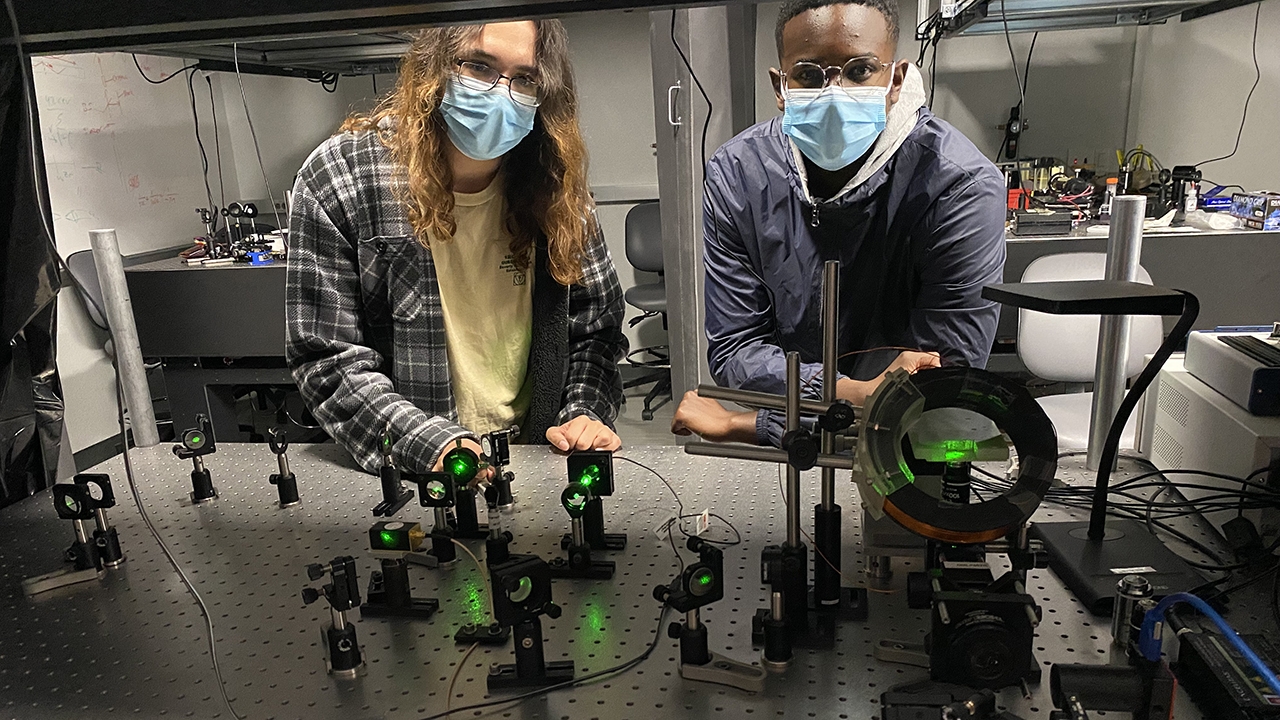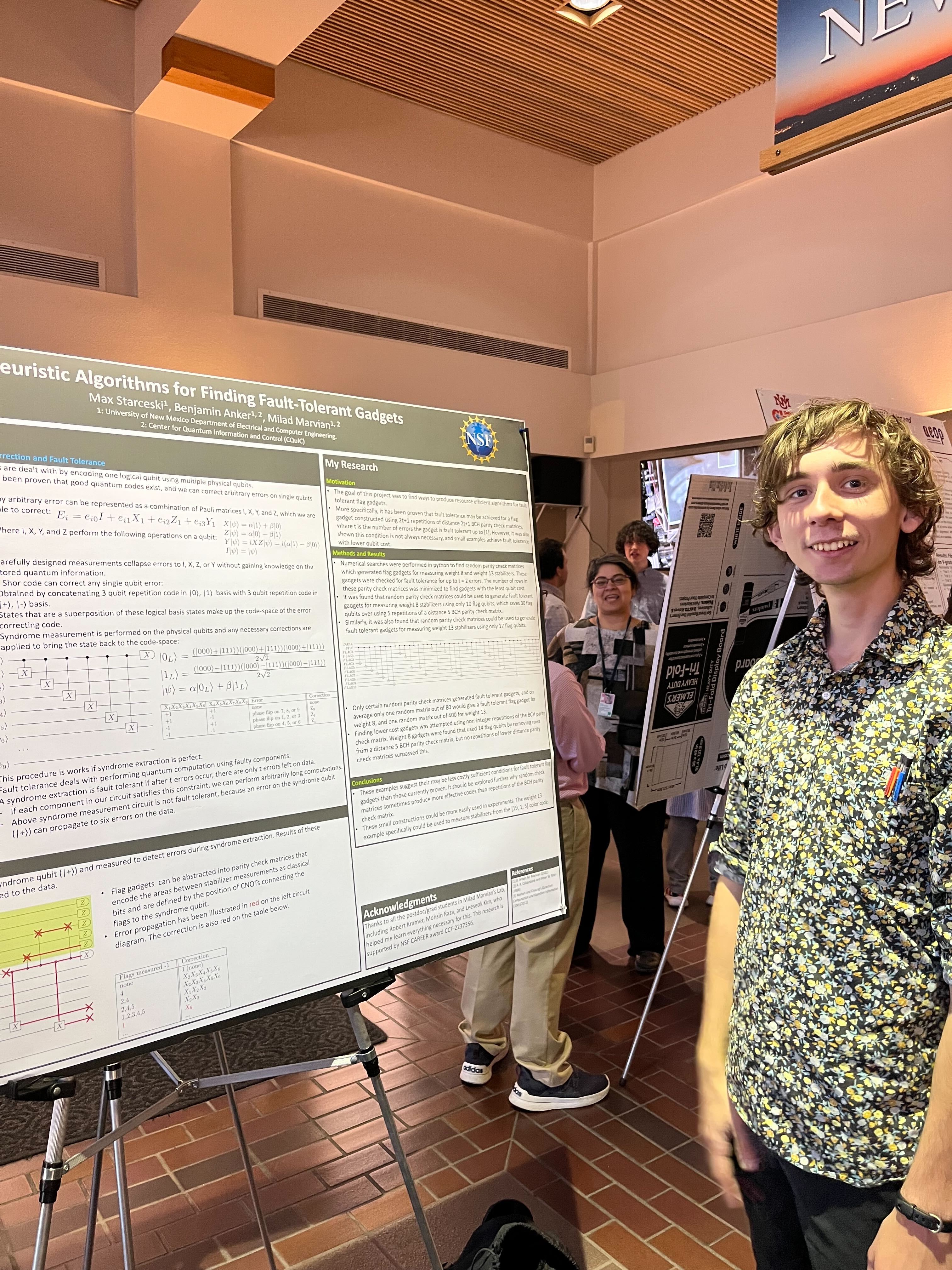Applications open for QU-REACH '24, quantum undergraduate research experience
February 13, 2024 - Carly Bowling
Quantum research could be the key to unlocking society’s next major technological advancement and demand for the skills and expertise required for such work is sure to grow. Now, for the fourth year in a row, students in New Mexico have the opportunity to gain hands-on experience in the competitive field of quantum technology.

Applications are open for the fourth-annual QU-REACH program, a 10-week summer undergraduate research program run by the Center for High Tech Materials (CHTM), academic departments at UNM, the Center for Quantum Information and Control (CQuIC) and Quantum New Mexico (QNM). The program focuses on three research areas: quantum computing, quantum communications and quantum sensing.
The program will take place from May 28 to Aug. 2, and participants will receive a $7,000 stipend. A limited number of housing stipends are also available for students attending schools outside the Albuquerque metro area. Students studying STEM at any college or university in New Mexico are invited to apply. Applications are due Friday, March 1.

Victor Acosta, an associate professor in UNM’s Physics and Astronomy department, helped develop the program with colleagues at CHTM and throughout the university. Acosta recognized an opportunity to create a research opportunity geared towards New Mexicans.
“It gives students in our state a leg up, specifically towards this topic of quantum technology, which is where our research is centered. It is a relatively new topic that might give an impression of being a little bit inaccessible, hard to get into, and requiring a fair amount of coursework,” Acosta said. “This program is part of our strategy to make quantum technology research more accessible to a broad range of New Mexico students.”
QU-REACH participants attend weekly seminars about quantum basics and new research findings presented by quantum researchers from UNM and the nearby national labs. The program culminates in a poster presentation attended by faculty.
Acosta encourages all interested STEM undergraduate students to apply, even those outside of Physics, as the program is designed to introduce students from a variety of educational backgrounds to the field of quantum technology. Faculty mentors belong to several UNM departments including Chemistry, Physics and Astronomy, Electrical and Computer Engineering and Mechanical Engineering.
“QU-REACH has a large variety of research projects related to quantum technology, so not necessarily someone building a quantum computer, but maybe doing some engineering research on a component that would go into a quantum computer or doing research into the basic chemistry that might be exploited in a quantum sensor.”
2024 research projects include:
- Quantum sensing with Nitrogen-Vacancy centers in diamond with Professor Victor Acosta
- Quantum Chemistry with Professor Susan Atlas
- Quantum dot single photon sources at telecom wavelengths with Professor Ganesh Balakrishnan
- Superconducting readout development for cosmic microwave background surveys with Professor Darcy Brown
- Precision measurements of simulated gravitational waves using optics interferometry with Professor Elohim Becerra
- Sub-Kelvin Cooling Using Momentum with Professor Stephen Boyd
- Piezoelectric optical filters and quantum fabrication with Professor Tito Busani
- Microresonator Optical Frequency Combs with Professor Tara Drake
- Nanofabrication of Multi-functional Materials for Quantum Bulk Acoustic Resonators with Professor Nathan Jackson
- Electron Transport and Optical Generation of Molecular Spin Qubits with Professor Martin L. Kirk
- Measuring Positions and Separations of Single Molecules at the Quantum Limit with Professor Keith Lidke.
- Quantum algorithms in the presence of noise with Professor Milad Marvian
- Charge dynamics in non-covalent supramolecular assemblies with Professor Jean-Hubert Olivier
- Silicon quantum photonic integrated circuits with Professor Marek Osinski
QU-REACH is supported by a combination of grants from Research Corporation for Scientific Advancement, Google Quantum AI, National Science Foundation, an EPSCoR Research Infrastructure Improvement Collaboration and the Q-SEnSE Quantum Leap Challenge Institute, among others. Students from historically excluded groups in STEM, including women, hispanic, American Indian, and Black students, as well as, first-generation college students are strongly encouraged to apply.

Maximillian Starceski, a junior studying electrical engineering at UNM, participated in QU-REACH last summer. Starceski worked with Professor Milad Marvian studying quantum information theory and achieving fault tolerance with flag gadgets.
“I went into the summer knowing absolutely nothing about quantum computing. I got to work full-time learning this fascinating new field of computing. Being able to focus on a single topic for the entire summer was a fantastic experience for me, and I would recommend it to anyone,” Starceski said.
Weekly seminars and working hands-on in a lab with graduate students left him feeling more prepared for graduate studies and the upper-division mathematics courses he is currently enrolled in.
“The work was very mathematically rigorous for me. Quantum computing involves a lot of applied linear algebra, and the work greatly expanded on all the topics that were covered in my undergraduate linear algebra class,” he said. “Because of that, I think I came into the spring semester more mathematically inclined than any of my peers.”
Acosta said the mentorship, research experience, and learning opportunities would not be possible without the passionate faculty who get involved with QU-REACH every year.
“The willingness of the faculty to spend their summers doing this is a key part of the program,” he said. “They do it because they love to see undergraduates have their first or second research experience and see the light in their eyes,” he said.
Learn more about the application, this year’s projects and frequently asked questions on the QU-REACH website.
View the original article written by Carly Bowling. It was published on Feb 13, 2024 at the UNM Newsroom.
